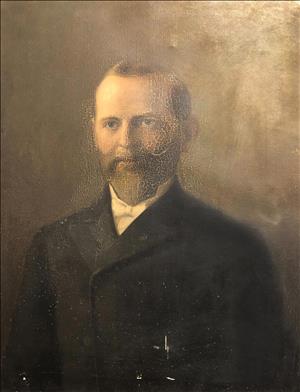On November 19, 1889, Judge Isaac Lichtenberg (1845-1905) hears the first case to be tried in King County Superior Court — the divorce trial of Smith vs. Smith — in a makeshift two-story building at Third Avenue and Jefferson Street in Seattle. Prior to that day, members of the state bar had met with Lichtenberg to establish and clarify procedures for the court. A committee of five, including Lichtenberg, Orange Jacobs (1827-1914), and attorneys John Arthur, Will H. Thompson (1848-1918), and P. P. Carroll drew up rules modeled in part on those of California. Lichtenberg was sworn in on November 18, 1889, by Probate Judge Richard Osborn (1845-1905), a Civil War veteran. The following day, Lichtenberg — also a Civil War veteran, and an amputee — went straight to work. He heard his first case and granted Mrs. Smith a divorce and custody of the couple's child.
Yesler's Cookhouse
Since the arrival of Seattle's first non-Native settlers in 1852, the town needed a place from which to conduct legal business and other governmental functions. Henry Yesler (1810?-1892) had become one of the county's largest landowners, and he offered his sawmill's cookhouse as a meeting place. That primitive structure served as a court, jail, church, hotel, and for other public uses during Seattle's first decade. In 1865 Yesler tore down the cookhouse to build a larger structure, and the activities of King County government had to move from one makeshift building to another until 1876, when the county bought a lot from Yesler at 3rd Avenue and Jefferson Street for $3,500. There a two-story building was constructed to hold the jail and the county auditor and clerk. A courtroom was added in 1881, but because the territorial government wasn't authorized to build a courthouse, it was dubbed the County Building. Washington gained statehood in 1889, and in 1890 the first bona fide courthouse was built at 7th Avenue and Alder Street.
The Constitution and the Courts
Washington's superior courts were established by the state constitution in 1889 as the various counties' trial courts of unlimited jurisdiction. The salary for superior court judges was fixed at $3,000, and the constitution allotted King County just one judge "until otherwise directed by the legislature" (Constitution, Art. IV, Sec. 5). When some 1,300 cases were filed in the court's first six months, it was clear more judges were needed. The state legislature increased the number of King County judicial positions to three, and Governor Elisha P. Ferry (1825-1895) appointed Julius Stratton (1844-1924) and Thomas J. Humes (1847-1904) to fill the two new positions until the general election of 1890. With a new courthouse still under construction on First Hill, the three judges were forced to divide up the single courtroom for their trials until they were able to move to their new, fireproof, neo-classical Victorian courthouse overlooking downtown.
All of King County's governmental operations were administered from Seattle, and much of the corporate business was centered in the city, so lawyers were in demand. By 1891 Seattle boasted 307 lawyers for a population of less than 50,000. As the population grew and the number of lawyers increased, so did the work of the court. There never seemed to be enough judges to keep up with the caseload.
In the early days of the superior court, judges were nominated by political parties and ran on their tickets. Judge Lichtenberg had been elected as a Democrat, and in 1890 Humes and Osborn ran as Republicans to serve with him (Stratton had declined to run.) At the 1892 election, however, Lichtenberg was defeated and a third Republican, J. W. Langley, was elected in his place. Four years later, all of them were swept from their seats in the populist wave of 1896, to be replaced by Democrats Orange Jacobs, William Hickman Moore (1861-1946) — who later would serve as Seattle mayor — and E. D. Benson. At that time, voting a "straight ticket" (that is, casting all one's votes for candidates of the same party) was easily done by a placing a single "x" at the top of a column of candidates. That mark selected every person in the party, regardless of experience or merit. This left the court subject to the political whims of the voters.
In the next election cycle the court was purged again, with the highly qualified Judge Jacobs — a former Chief Justice of the Territorial Supreme Court, two-term congressional delegate, and former Seattle mayor — being ousted along with the other two Democrats, and three Republicans taking over the court. By 1908 it had become clear that judges shouldn't be aligned with political parties, and for the first time they ran independently. Two years later, Washington women permanently won the vote, and with their votes began to create change. In 1914, Reah Mary Whitehead (1883-1972) defeated nine male candidates to be elected justice of the peace for King County, the first woman to hold that position.
By that time, a new courthouse was under construction on 3rd Avenue between James Street and Yesler Way. Designed by architect A. Warren Gould (1871-1922), the five-story, beaux arts-style building was framed in steel and reinforced concrete, elaborately finished with a granite exterior, and bronze light fixtures, window frames and balustrades. Two and a half acres of Alaska marble were cut for the interior walls.
That structure has since been added to and remodeled over the years. First came a six-story addition and remodel in 1931. In 1967 the building got a mechanical upgrade and '60s-style facelift, with the addition of more courtrooms and office space. In 1987 the courthouse was designated a historic landmark, and some parts have been restored to their original style as funds have become available.

